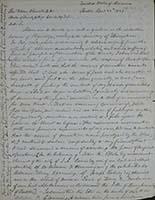Área de identidad
Código de referencia
Título
Fecha(s)
- 24 Apr. 1849 (Creación)
Nivel de descripción
Volumen y soporte
4 pp
Área de contexto
Nombre del productor
Institución archivística
Historia archivística
Origen del ingreso o transferencia
Área de contenido y estructura
Alcance y contenido
Boston, USA - CTJ's place in the history of the inductive science of physiology, relating to the discovery of etherism. He gives an account of his experience with ether. His experiments 'led me to conclude that the nerves of sensation were paralysed by the ether, and I ventured to declare confidently to my friends, that I had discovered a means of averting the pain of surgical operations'. CTJ wants WW to sanction his claim as the discoverer of the application of ether in surgical operations.
Valorización, destrucción y programación
Acumulaciones
Sistema de arreglo
Área de condiciones de acceso y uso
Condiciones de acceso
Condiciones
Idioma del material
Escritura del material
Notas sobre las lenguas y escrituras
Características físicas y requisitos técnicos
Instrumentos de descripción
Área de materiales relacionados
Existencia y localización de originales
Existencia y localización de copias
Unidades de descripción relacionadas
Área de notas
Notas
William T G Morton, a student of CTJ's, had demonstrated to a group of students and physicians in October 1846 the use of ether as a general anesthetic, and applied for a patent. CTJ in turn claimed he had discovered it. He also claimed to have told Samuel F. B. Morse the principles of the electric telegraph which Morse had patented in 1840. In 1873 he was committed to McLean Hospital as mentally ill. See his entry in the DSB by George E. Gifford, Jr., Vol. VII, pp. 44-46]

